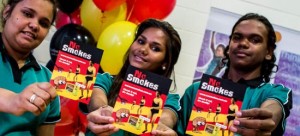
The No Smokes anti-smoking website uses animations, games, videos, music and downloadable educational tools to explain addiction, talk about the effects of smoking and promote quitting strategies.
It is an anti-smoking resource with a difference. The site uses Aboriginal and Torres Strait Islander faces and themes to deliver messages. The videos and animations were developed with input from young Aboriginal and Torres Strait Islander people, as well as health workers and teachers.
Some of the features of the website include Aboriginal comedian Sean Choolburra doing a take-off of Beyoncé’s “All the Single Ladies” as “All the Cigarettes”, as well as a hip hop dance-off where you can become one of the virtual hip hop crew, and a video animation that shows how smoking addiction works, including the link between smoking and a powerful brain chemical called Dopamine. The games on the site are funny and engaging and the music is deadly.
Head of the ‘No Smokes’ project, Dr Sheree Cairney is a former Menzies School of Health Researcher and she has been studying the effects of drugs on the brain for most of her career as a researcher. She and her team have developed a range of community tools to assist people to stop smoking under the ‘No Smokes’ website.
While smoking rates in the general Australian population have dropped from 30% to 17% over the last 30 years, due to public-health campaigns – the same reduction has not been seen in the Aboriginal and Torres Strait Islander population. It is still 50% in these communities.
“Significantly, 62% of Aboriginal and Torres Strait Islander households have smokers in them, which can lead to passive smoking. The alarming statistics are now that one in four people die from passive smoking. One in five deaths in the Aboriginal and Torres Strait Islander population are smoking related. Smoking has been identified as the number-one preventable contributor to the health gap between black and white Australians – with smoking responsible for 17% of this gap,” Sheree says.
“So the message is not getting out to Aboriginal and Torres Strait Islander people. They are taking it up as young as age 12. We need to intervene at that level to try and stop young people from starting or to help them quit if they have started.”
She says part of the research that went into producing the website included focus group interviews of the target group in remote, rural and urban settings.
“Focus group interviews were held in Melbourne, Darwin and Arnhem Land, as well as through social media,” she says.
“We wanted to understand how young people access information and we have developed a multimedia health campaign as a result of this research that targets young people, teachers and health workers.
“A lot of the material out there was not culturally appropriate, so we have a lot of Aboriginal and Torres Strait Islander faces and role models on our website. In the animations, we have tried to use language that is clear, without too much technical language. It is about empowering people through knowledge.
The ‘No Smokes’ website was launched on World No Tobacco Day on May 31 this year, and the teachers’ package was launched last week. The health-workers’ section and training will be available by the end of the year.
“In the surveys and interviews, young people were less concerned about the long-term health effects of smoking, such as chronic disease, but they were concerned about changes to their brains as a result of addiction,” Sheree says.
“The younger people are when they start – the longer they stay smoking. As the brain develops it sets up expectations for substances – this is the same for all drugs.
“But everyone is different in how they give up. Some people will be able to give up more easily than others. The statistics show it takes up to eight attempts to actually quit – so the message is to keep trying.”
Sheree says the No Smokes campaign also reaches across social media such as Facebook, Twitter and YouTube, as well as translating the audio and video material into various Aboriginal and Torres Strait Islander languages.
She also encouraged health workers who were interested in accessing the training that will accompany the health-workers package, to get in touch with the No Smokes team via this email address: [email protected]
The No Smokes website is www.nosmokes.com.au
Comments are closed.